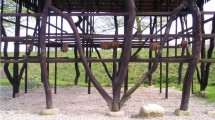Abstract
In this paper, ideas and methods for utilising crooked sawlogs in construction are presented. The paper discusses a current problematic reality and, through a selected scenario, proposes a workflow that handles a series of challenges that arises when working with irregular wood. Through an investigative working method and by utilising computation and digital manufacturing technologies, the workflow integrates material properties with architectural design tools. The research focusses on oak logs which have been discarded by the timber industry due to their irregular shapes. Oak is a hardwood with structural properties, but often grows into crooked geometries. Through procedures for 3D-scanning, data handling, analysis, and evaluation methods, informed machining and utilisation of the logs are made possible. Numerous crooked sawlogs are handled in parallel physical and digital stockpiles. The digital stockpile holds layers of information generated from the sawlogs. When given an input geometry, the workflow matches the geometry with sawlogs found in the digital stockpile, and using procedures for developing and detailing, a realised version of the geometry can be machined and constructed using digital fabrication methods. The workflow includes multiple custom-made methods and algorithms for handling the complex and different shapes and data of crooked sawlogs in a highly digitised machining and fabrication environment. A constant link and the dialogue between digital data and physical reality are maintained and used actively in both design and fabrication strategy. The suggested up-cycling of irregular sawlogs using non-standard methods is a critical articulation of today’s linear material economy as the research illustrates how the natural forms and properties of materials can be used to rethink existing design and material practise. This paper is an expansion and further development of work presented at ACADIA 2019 (Larsen et al. in Ubiquity and autonomy, The University of Texas at Austin School of Architecture, Austin, 2019).














Similar content being viewed by others
References
Andersen E (1997) Roar Ege: skuldelev 3 skibet som arkaeologisk eksperiment. Vikingeskibshallen, Roskilde
Delanda M (2007) Opportunities and risks. Domus No 901:192–193
Gustavsson L, Madlener R, Hoen H-F et al (2006) The role of wood material for greenhouse gas mitigation. Mitig Adapt Strateg Glob Change 11:1097–1127. https://doi.org/10.1007/s11027-006-9035-8
Hoadley RB (2000) Understanding wood: a craftsman’s guide to wood technology, 1st edn. The Taunton Press, Newtown
Krieg O, Christian Z, Correa Zuluaga D et al (2014) HygroSkin—meteorosensitive pavilion. Fabricate 2014:272–279
Larsen NM, Aagaard AK (2019) Exploring natural wood. In: Bieg K, Briscoe D, Odom C (eds) Ubiquity and autonomy. The University of Texas at Austin School of Architecture, Austin
Laturi J, Mikkola J, Uusivuori J (2008) Carbon reservoirs in wood products-in-use in Finland: current sinks and scenarios until 2050. Silva Fenn. https://doi.org/10.14214/sf.259
Menges A (2012) HygroScope—Meteorosensitive Morphology. In: Gattegno N, Price B, Association for Computer-Aided Design in Architecture, ACADIA (Conference) (eds) ACADIA 2012: Synthetic Digital Ecologies : project catalogue of the 32nd annual conference of the Association for Computer Aided Design in Architecture, ACADIA. ACADIA, New York
Menges A, Schwinn T, Krieg OD (2016) Advancing wood architecture: a computational approach, 1st edn. Routledge, London/New York
Mollica Z, Self M (2016) Tree fork truss—geometric strategies for exploiting inherent material form. In: Adriaenssens S, Gramazio F, Kohler M, et al (eds) Advances in architectural geometry 2016. vdf Hochschulverlag AG
Stangeland SH, Kropf R (2012) Relational Practice. In: Hensel M (ed) Design innovation for the built environment: research by design and the renovation of practice. Routledge, Oxon/New York, pp 171–188
Tamke M, Riiber J, Jungjohann H (2010) Generated lamella. In: ACADIA 10: LIFE in:formation, on responsive information and variations in architecture [Proceedings of the 30th Annual Conference of the Association for Computer Aided Design in Architecture (ACADIA) ISBN 978-1-4507-3471-4] New York 21–24 October, 2010), pp. 340–347. CUMINCAD
Ursella E (2018) A Fast and Continuous CT scanner for the optimization of logs in a sawmill. In: iCT 2018, Wels, Austria
Von Buelow P, Oliyan Torghabehi O, Mankouche S, Vliet K (2018) Combining parametric form generation and design exploration to produce a wooden reticulated shell using natural tree crotches. In: Caitlin M, Sigrid A (eds) Proceedings of the IASS symposium 2018 creativity in structural design, MIT, Boston, USA
Author information
Authors and Affiliations
Corresponding author
Additional information
Publisher's Note
Springer Nature remains neutral with regard to jurisdictional claims in published maps and institutional affiliations.
Rights and permissions
About this article
Cite this article
Larsen, N.M., Aagaard, A.K. Robotic processing of crooked sawlogs for use in architectural construction. Constr Robot 4, 75–83 (2020). https://doi.org/10.1007/s41693-020-00028-7
Received:
Accepted:
Published:
Issue Date:
DOI: https://doi.org/10.1007/s41693-020-00028-7




